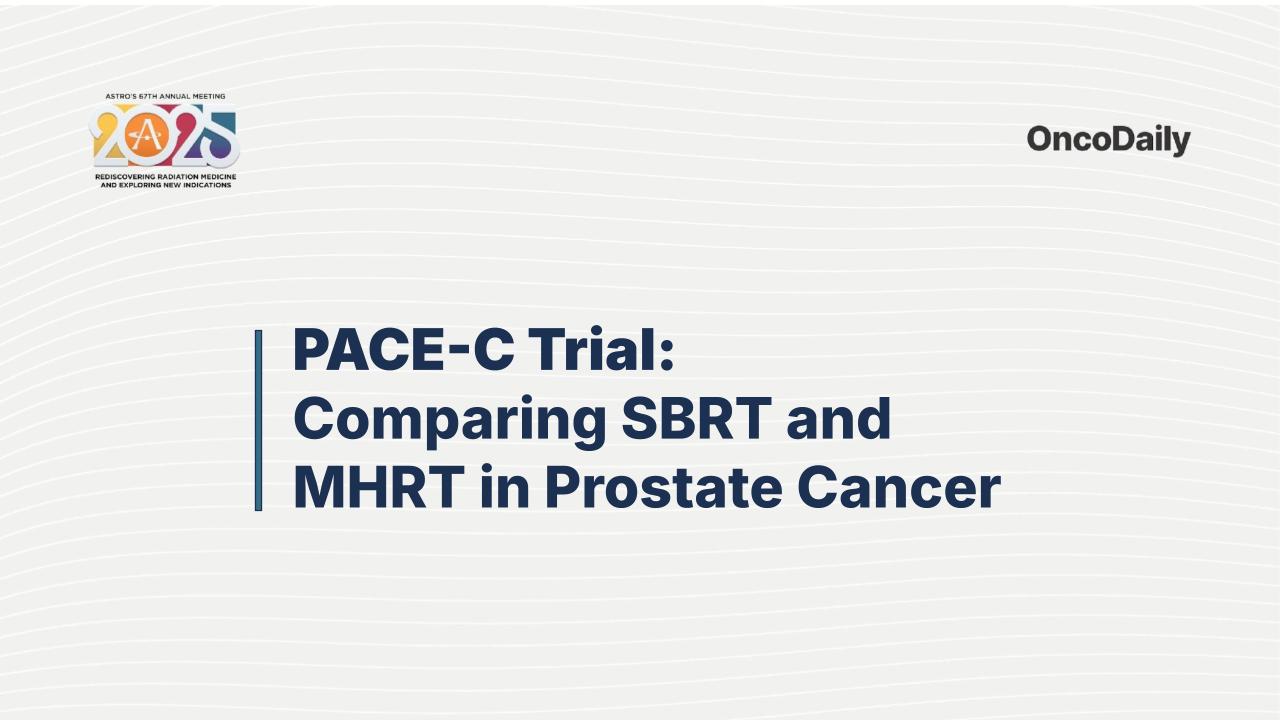Authors: R. Ratnakumaran, V. Hinder, A. Chan, S. Tolan, P. Ostler, H. Van Der Voet, O. Naismith, S. Jain, A. Martin, D. Price, B. O’Neil, A. Duffton, J. Staffurth, G. Sasso, J. Pugh, G. Manning, S. Brown, N. van As, E. Hall, and A. Tree
The phase III PACE-C trial has presented late toxicity outcomes comparing stereotactic body radiotherapy (SBRT) with moderately hypofractionated radiotherapy (MHRT) in men with intermediate- and high-risk localized prostate cancer receiving androgen deprivation therapy (ADT).
Study design
PACE-C enrolled a total of 1,208 men with localized prostate cancer, defined as stage T1c–T3a, Gleason score ≤4+4, and baseline PSA ≤30 ng/mL. Participants were randomly assigned in a 1:1 ratio to receive either SBRT or MHRT. The SBRT arm delivered 36.25 Gy in five fractions over one to two weeks, while the MHRT arm delivered 60 Gy in 20 fractions over four weeks. All patients were scheduled to receive six to twelve months of androgen deprivation therapy, ensuring a consistent systemic treatment backbone.
Late toxicity was prospectively evaluated using both RTOG and CTCAE grading systems at multiple time points up to two years after treatment, specifically at 6, 9, 12, 18, and 24 months. The co-primary endpoints were the incidence of grade 2 or higher gastrointestinal (GI) and genitourinary (GU) toxicities at the two-year mark. Secondary endpoints included cumulative incidence of these toxicities over time as well as patient-reported quality of life, assessed with EPIC-26 urinary and bowel domains.
Results
Genitourinary toxicity:
- Higher with SBRT: RTOG G2+ GU at 2 years was 9% vs. 3% (p<0.0001).
- CTCAE G2+ GU at 2 years was 13% vs. 4% (p<0.0001).
- Cumulative 2-year incidence reached 24% (RTOG) / 32% (CTCAE) for SBRT vs. 10% / 13% for MHRT.
Gastrointestinal toxicity:
- Similar between groups. RTOG G2+ GI at 2 years: 2% vs. 2% (p=0.71).
- CTCAE G2+ GI at 2 years: 3% vs. 3% (p=0.67).
- Cumulative 2-year incidence was 8% (RTOG) / 13% (CTCAE) for SBRT vs. 6% / 10% for MHRT.
Patient-reported outcomes (EPIC-26):
- Minimally clinically important difference (MCID) in urinary irritative/obstructive scores was more frequent with SBRT (46% vs. 27%, p<0.0001).
- No meaningful difference in urinary incontinence (32% vs. 25%, p=0.012) or bowel function (38% vs. 32%, p=0.047).
- Severe toxicity: Grade ≥3 GI and GU toxicities remained <2% in both groups.
Takeaway
PACE-C provides important early evidence on the trade-offs between SBRT and MHRT in the management of intermediate- and high-risk prostate cancer treated with ADT. At the two-year mark, SBRT offered the convenience of a much shorter treatment schedule but was associated with a higher incidence of urinary toxicity compared to MHRT. Bowel outcomes, by contrast, were largely indistinguishable between the two approaches, and severe adverse events were uncommon overall.
These findings suggest that while SBRT can be delivered safely in this higher-risk population, it is not without drawbacks, particularly regarding urinary side effects. Patients and clinicians must therefore weigh the advantages of shorter treatment duration and resource efficiency against the potential for increased urinary morbidity. Importantly, the results presented are limited to late toxicity outcomes at two years; longer-term follow-up is critical to assess not only whether SBRT remains non-inferior in terms of toxicity but also whether oncologic outcomes, such as disease control and survival, match those of MHRT. The five-year efficacy and toxicity data, once available, will be essential in defining the role of SBRT as a standard option in intermediate- and high-risk prostate cancer.
